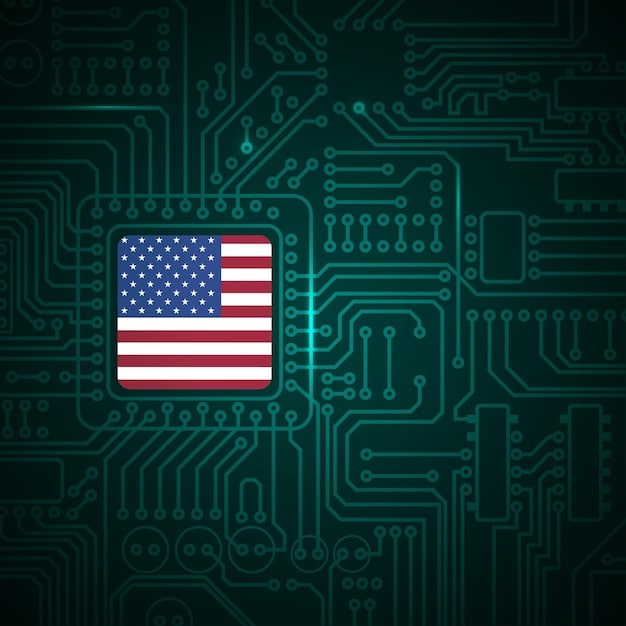CBDCs in the US: Exploring Digital Payment Innovations

Digital payment innovations are rapidly evolving, and Central Bank Digital Currencies (CBDCs) represent a potentially transformative step in the US financial landscape, offering both opportunities and challenges.
The world of finance is constantly changing, and one of the most talked-about developments is the rise of digital payment innovations, particularly the exploration of Central Bank Digital Currencies (CBDCs) in the US. This article delves into the potential of CBDCs, their implications, and what they could mean for the future of money in America.
Understanding Central Bank Digital Currencies (CBDCs)
Central Bank Digital Currencies, or CBDCs, are a new form of digital money issued and backed by a nation’s central bank. Unlike cryptocurrencies like Bitcoin, which are decentralized, CBDCs would be centralized and regulated by the government, similar to traditional fiat currencies but in a digital format.
How CBDCs Differ from Cryptocurrencies
The key difference lies in the issuer and the level of control. Cryptocurrencies operate on a decentralized network, while CBDCs are controlled by the central bank. This control allows for greater stability but also raises concerns about privacy and government oversight.
The Potential Benefits of CBDCs
CBDCs offer several potential advantages, including reduced transaction costs, increased financial inclusion, and improved efficiency in payment systems. They could also streamline the distribution of government benefits and aid in combating illicit financial activities.
- Reduced Transaction Costs
- Increased Financial Inclusion
- Improved Payment System Efficiency
- Streamlined Government Benefit Distribution
In essence, CBDCs aim to combine the convenience of digital currencies with the stability and trust of traditional fiat currencies.

The Current Landscape of Digital Payments in the US
The US already has a robust digital payment ecosystem, with various options available to consumers, including credit cards, debit cards, and mobile payment apps. However, these systems are not without their limitations.
Popular Digital Payment Methods
Methods like Visa, Mastercard, PayPal, and Apple Pay dominate the digital payment landscape. These systems offer convenience but can also involve transaction fees and security risks.
Challenges with Existing Digital Payment Systems
One major challenge is the exclusion of unbanked and underbanked populations from the digital economy. Existing systems often require a bank account or credit card, leaving out a significant portion of the population.
Additionally, the digital payments space is susceptible to fraud and cybersecurity threats, necessitating continuous innovation in security measures.
- Exclusion of Unbanked Populations
- Transaction Fees
- Security Risks and Fraud
CBDCs could potentially address these challenges by providing a more inclusive and secure digital payment option.
Exploring the Potential Impact of CBDCs in the US
The introduction of CBDCs in the US could have far-reaching effects on the economy, financial institutions, and consumers. The impact could be transformative, reshaping how money is used and managed.
Economic Benefits and Efficiencies
CBDCs could reduce transaction costs, increase the speed of payments, and improve the efficiency of the financial system. These efficiencies could stimulate economic growth and innovation.
Financial Inclusion and Accessibility
By providing a digital form of money directly accessible to all citizens, CBDCs could promote financial inclusion. This would allow unbanked individuals to participate more fully in the economy.

Potential Risks and Challenges
However, CBDCs also pose several risks and challenges. Concerns about privacy, cybersecurity, and the potential for government surveillance need to be addressed.
A well designed and properly regulated CBDC could bring significant benefits to the US economy, while a poorly implemented one could lead to economic instability.
Regulatory and Policy Considerations for CBDCs
The implementation of CBDCs requires careful regulatory and policy considerations. Policymakers must address issues such as privacy, security, and the role of the private sector.
Privacy Concerns and Data Protection
Ensuring the privacy of CBDC users is crucial. Policymakers need to establish clear rules and regulations to protect personal data and prevent misuse of information.
Cybersecurity and Fraud Prevention
Robust cybersecurity measures are essential to protect CBDCs from hacking and fraud. This includes developing advanced security technologies and implementing effective risk management strategies.
The Role of the Federal Reserve and Government Agencies
The Federal Reserve and other government agencies will play a key role in regulating and overseeing CBDCs. Their responsibilities will include setting standards, monitoring compliance, and enforcing regulations.
- Establishing Privacy Regulations
- Implementing Cybersecurity Measures
- Defining the Role of the Federal Reserve
Successfully navigating these regulatory and policy considerations is essential for the successful adoption of CBDCs in the US.
CBDCs and the Future of the US Financial System
The introduction of CBDCs could reshape the US financial system, impacting traditional banks, payment processors, and other financial institutions. It’s essential to consider the long-term implications and adapt accordingly.
Impact on Traditional Banks and Financial Institutions
CBDCs could potentially disrupt the traditional banking model by reducing the need for intermediaries. Banks may need to adapt their business models to remain competitive.
Integration with Existing Payment Systems
Seamless integration with existing payment systems is crucial for the widespread adoption of CBDCs. This requires collaboration between government, financial institutions, and technology providers.
The Role of Fintech Companies and Innovation
Fintech companies can play a vital role in developing innovative solutions for CBDCs, such as user-friendly wallets and payment applications.
Real-World Examples and International CBDC Initiatives
Several countries are already exploring and implementing CBDCs, providing valuable insights and lessons learned for the US. These international efforts offer a glimpse into the potential future of digital currencies.
China’s Digital Yuan (e-CNY)
China has been at the forefront of CBDC development with its digital yuan, also known as e-CNY. The e-CNY is being tested in various cities, with plans for wider adoption in the future.
The Bahamas’ Sand Dollar
The Bahamas launched the Sand Dollar, one of the first fully operational CBDCs, in 2020. The Sand Dollar aims to improve financial inclusion and streamline payments in the island nation.
Other Countries Exploring CBDCs
Many other countries, including Sweden, Canada, and the UK, are actively researching and experimenting with CBDCs. These initiatives provide valuable data and insights for the US to consider.
- China’s e-CNY Pilot Programs
- The Bahamas’ Sand Dollar Implementation
- Research Efforts in Sweden, Canada, and the UK
Studying these real-world examples can help the US avoid potential pitfalls and optimize the design and implementation of its own CBDC.
| Key Aspect | Brief Description |
|---|---|
| 💰 Financial Inclusion | CBDCs can provide access to digital payments for unbanked populations. |
| 🛡️ Security Concerns | Robust cybersecurity measures are essential to protect CBDCs from fraud. |
| 🌐 International Examples | China’s e-CNY and the Bahamas’ Sand Dollar offer valuable insights. |
| 🏦 Impact on Banks | Traditional banks may need to adapt their business models to CBDCs. |
Frequently Asked Questions (FAQs)
▼
A Central Bank Digital Currency (CBDC) is a digital form of a country’s fiat currency, issued and regulated by the central bank. It is designed to be a secure and efficient means of digital payment.
▼
CBDCs are centralized and regulated by the central bank, while cryptocurrencies are decentralized and operate on a blockchain network. CBDCs maintain stability, while cryptocurrencies are often volatile.
▼
CBDCs could offer several advantages, including reduced transaction costs, increased financial inclusion by reaching unbanked populations, and improved efficiency in the payment system.
▼
Some potential risks include privacy concerns, cybersecurity threats, and the possibility of government surveillance. Policymakers need to address these concerns to ensure successful implementation.
▼
CBDCs have the potential to disrupt the traditional banking model by reducing the need for intermediaries. Banks may need to adapt their business models to effectively compete.
Conclusion
In conclusion, digital payment innovations and Central Bank Digital Currencies (CBDCs) hold significant potential for transforming the US financial system. While there are challenges and risks to consider, the opportunities for increased efficiency, financial inclusion, and innovation are substantial. Careful planning, regulation, and collaboration will be essential to successfully navigate this evolving landscape and harness the full potential of CBDCs in the US.





